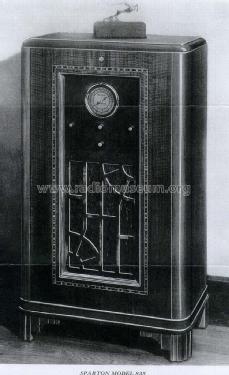- País
- Estados Unidos
- Fabricante / Marca
- Sparks-Withington Co., (Sparton); Jackson, Michigan
- Año
- 1934/1935

- Categoría
- Radio - o Sintonizador pasado WW2
- Radiomuseum.org ID
- 226310
Haga clic en la miniatura esquemática para solicitarlo como documento gratuito.
- Numero de valvulas
- 9
- Principio principal
- Superheterodino con paso previo de RF; ZF/IF 456 kHz; 2 Etapas de AF
- Número de circuitos sintonía
- 9 Circuíto(s) AM
- Gama de ondas
- OM y más de dos OC
- Tensión de funcionamiento
- Red: Corriente alterna (CA, Inglés = AC) / 125, 150, 250 Volt
- Altavoz
- Altavoz electrodinámico (bobina de campo)
- Material
- Madera
- de Radiomuseum.org
- Modelo: Sparton 835 - Sparks-Withington Co., Sparton
- Forma
- Consola en general
- Anotaciones
-
The Sparton model 835 receives the following bands: Broadcast 550 - 1500 kHz and the SW bands 1.4 - 3.4 MHz, 3.3 - 8 MHz and 7.5 - 19 MHz. Rider's shows the same schematic for models 80, 83, 84, 85-X and 86-X but the original schematic shows also model 85-XS and this model 835. Since it has the same chassis as model 83 with VisoGlo we presume that this "higher" model has it too. There are two models 83, one with the VisoGlo tuning indicator and the other without but in principle the same chassis. VisoGlo tuning indicator VG-1 is extremely rare, even in the literature it is nearly not noticed.
See the article here about season 1934/35.
- Ext. procedencia de los datos
- Original schematic diagram manual 2, bulletin 27-2
- Documentación / Esquemas (1)
- -- Schematic
- Autor
- Modelo creado por Ernst Erb. Ver en "Modificar Ficha" los participantes posteriores.
- Otros modelos
-
Donde encontrará 817 modelos, 365 con imágenes y 754 con esquemas.
Ir al listado general de Sparks-Withington Co., (Sparton); Jackson, Michigan
Contribuciones en el Foro acerca de este modelo: Sparks-Withington Co: Sparton 835
Hilos: 1 | Mensajes: 1
This Sparton model 835 from Sparks-Withington Co. and several other models with the same chassis but different cabinets were at least intended to be built with a pentode type 78 as first detector. Models found use a hexode type 6A7 as first detector. Both work with a type 78 as "Super-Control Radio Frequency Amplifier" in front and a type 76 triode oscillator and also the other tubes are identical. The original schematic from manual 2, bulletin 27-2 shows the hexode mixer and is for models 80, 83, 84, 85-X, 85-XS, 86-X and 835. The Rider's seems to be a copy, only left out the titles, omitting to name models 85-XS and 835. But the description I have loaded up is for the pentode mixer...
Description for Model 835
Original text from Sparks-Withington:
DESCRIPTION: An exquisite example of typical modern design with recessed instrument panel and grille. It is decorated in sliced walnut with inlays of tulip English harewood and ebony. This beautiful lowboy console will add distinction to any living room.
The performance of this model is fully up to that anticipated by cabinet-appearance, an all-wave world receiver reproducing the finest programs faithfully and with all the impressive volume that may ever be desired.
CHASSIS: The eight-tube superheterodyne for 110 volt, 60 cycle, AC operation has four wave bands with color identification. The whole range from 540 kilocycles to 20 megacycles is covered.
PROGRAMS: This embraces American broadcasts, all the fine programs now originating in Europe, South America and other foreign lands. Then, variety and intense interest of police, aeroplane, amateur, commercial and ship communications are always available.
FEATURES: Th full automatic volume control maintains a steady, even volume at the selected level. A tone control gives any desired shading of tone from the deep sonorous to the brilliant to suit the occasion or the individual. When tuning between stations an inter-station noise suppressor prevents reproduction of the background noises, which an extremely sensitive set of this kind would otherwise pick up.
Clarity and faithfulness of the Model 835 performance results from the use of Class A amplification with pentode output and adequately baffled twelve-inch speaker.
VISION TUNING: There is also a unique visual tuning indicator located above the dial. As the correct tuning position of each station is approached a small six-ponted star grows in size, and when the station is properly tuned in, the star-points are completely filled with soft, rose-colored light. This insures the best possible performance obtainable from that program.
TUBES: The following tubes, some of which are of the double duty type, operate in circuits designed for highest efficiency in their individual functions:
78: Radio Frequency Amplifier
78: First Detector
76: Triode Oscillator
78; First Intermediate Frequency Amplifier
78: Second IF Amp.
85: Duplex-Diode-Triode Second Detector AVC
42: Power Output Pentode
80: Full-Wave Rectifier
(not listed is the VG-1 VisoGlo)
TUNING: Special provision for ease in tuning to foreign and short-wave frequencies is made in a 15-to-1 step-down tuning ratio and in the calibrated aeroplane type dial. The position where the various classes of broadcasts are found is printed on the dial and can be easily read at all times, because of the complete illumination.
SIZE: 39" high, 23 5/8" wide, 12 3/8" deep.
Ernst Erb, 29.Nov.12



